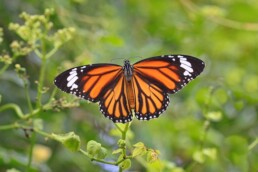Monarch butterfly
Scientific name
The monarch butterfly is scientifically known as Danaus plexippus.
Family
It belongs to the family Nymphalidae, which is a family of butterflies known for their diversity and beauty.
Distribution and Habitat
Monarch butterflies have a distribution spanning North America, from Canada to Mexico. They are known for their impressive seasonal migrations. During the winter, millions of monarch butterflies gather in colonies in certain oyamel forests in Mexico and in some areas of California.
Behaviour
Monarch butterflies are famous for their massive migrations, which can span thousands of kilometres. They perform an annual migratory cycle between their breeding grounds in North America and their overwintering grounds in Mexico. During migration, these butterflies can fly great distances.
Feeding Habits
Monarch butterflies are known for their larval feeding. Monarch caterpillars feed exclusively on plants of the Asclepiadaceae family, especially the plant known as milkweed (Asclepias). These plants contain toxins that the caterpillars accumulate in their bodies, making them unpalatable to predators.
Reproduction
Monarch butterfly reproduction involves the laying of eggs on milkweed plants by females. Caterpillars emerge from the eggs and feed on the leaves of host plants. After completing their larval development, the caterpillars transform into chrysalises and eventually into adult butterflies. Adult butterflies lay eggs and continue the cycle.
It is important to note that the mass migrations of monarch butterflies are an amazing and unique natural phenomenon in the wildlife world.



